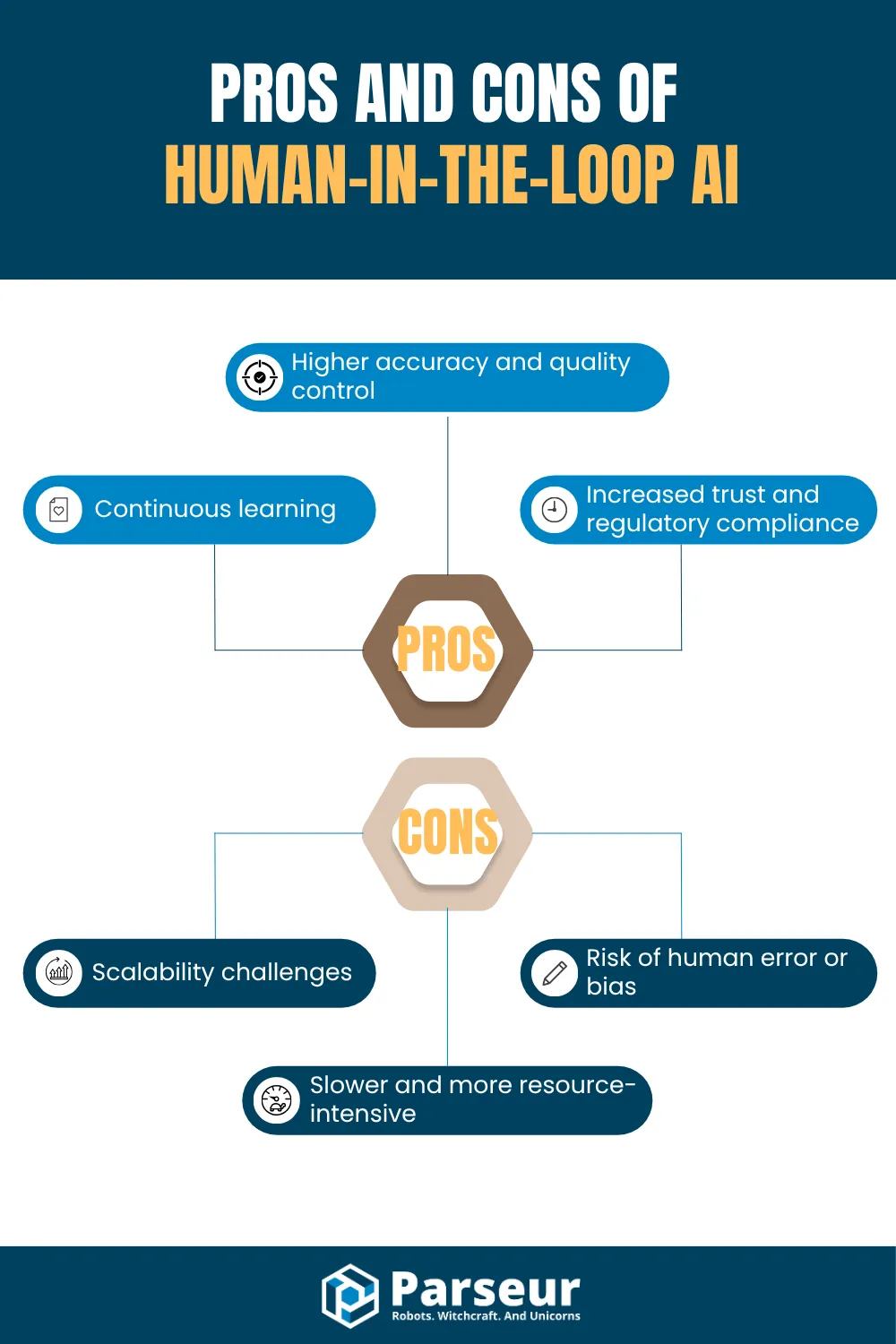Key Takeaways
- Human-in-the-Loop AI (HITL) combines AI with human oversight to improve accuracy and fairness.
- It follows a feedback loop: data labeling, prediction, human correction, and model refinement.
- HITL is used in document processing, customer support, medical diagnostics, and fraud detection.
- It offers better control but can be slower and more challenging to scale than full automation.
What Is Human-in-the-Loop AI?
Human-in-the-Loop AI (HITL) is an approach to artificial intelligence that integrates human feedback or oversight at key stages of an AI system’s operation. Simply put, a person remains actively involved in reviewing, guiding, or correcting the AI’s decisions to improve accuracy, fairness, and overall performance.
McKinsey shows organizations rapidly deploying AI but emphasizes governance and risk management as AI matures. With 71% of organizations now using generative AI, the role of Human-in-the-Loop AI (HITL) is more critical than ever.
Instead of allowing AI to function entirely independently, HITL systems keep humans involved, especially in areas where judgment, ethical considerations, or quality control are important.
This method is frequently applied during machine learning model training, output validation, and system refinement through continuous feedback. It is particularly valuable in industries where decisions carry real-world consequences, such as healthcare, finance, legal services, or large-scale document processing.
It is also a key part of effective human-AI collaboration. It ensures that AI tools automate tasks efficiently and produce outcomes that align with human values, business goals, and compliance standards.
81% of business leaders believe that Human-in-the-Loop AI is important for their organization, as reported by Clanx.
Visit our detailed Human-in-the-Loop AI: Definition, Benefits & 2026 Trends to learn more about HITL's foundational role in AI development, including its benefits, implementation strategies, and future trends.
How Does Human-in-the-Loop AI Work?
HITL AI integrates human involvement into the AI development and decision-making process. This collaboration allows humans to guide, review, and refine AI outputs at key stages to ensure accuracy, fairness, and contextual understanding. Rather than training and deploying an AI model in isolation, HITL creates a continuous feedback loop where humans play an essential role in shaping and improving the system over time.
Human-in-the-Loop AI (HITL) creates a continuous, iterative feedback loop between humans and AI. Humans guide AI through critical stages, significantly enhancing accuracy and improving up to 40% compared to automated approaches alone (Eyt).
The typical HITL workflow follows a structured cycle:
- Data Annotation: Human experts label or organize the raw training data, helping the AI understand what to learn. For example, in a document parsing system, people may tag invoice fields such as date, amount, and vendor to teach the AI how to recognize these elements correctly.
- Model Prediction: After training, the AI generates predictions or decisions based on the data it has seen. This could be anything from identifying transaction patterns to extracting information from emails or scanned documents.
- Human Feedback: People then evaluate the AI’s outputs, flagging inaccuracies, correcting mistakes, or offering suggestions for improvement. This human input adds context that the AI alone might miss.
- Model Improvement: Using the feedback it receives, the AI retrains or updates its behavior. Over time, this iterative loop helps the system become more accurate and reliable, especially in complex or nuanced tasks.
Some advanced HITL systems also use active learning, where the AI proactively identifies uncertain cases and requests human input. This ensures that human effort is focused only where it's most needed, increasing efficiency.
Human oversight often remains in place even after an AI system is deployed. In high-stakes domains like healthcare, finance, or legal review, people continue to monitor AI decisions to prevent critical errors and ensure compliance. This end-to-end collaboration allows organizations to take advantage of AI’s speed and scalability while maintaining human control where it matters most.
Use Cases Of Human-in-the-Loop AI
HITL AI is used across various industries where human oversight is critical in ensuring the reliability, fairness, and safety of AI-driven processes. This approach is especially valuable in environments that balance automation and accountability.
According to Expert Beacon, integrating human feedback in image classification improved accuracy from 91.2 percent to 97.7 percent, demonstrating how HITL can significantly boost model performance
Here are several real-world applications where HITL adds meaningful value:
Improving Document Processing Accuracy with HITL
AI systems are trained to extract structured information from unstructured documents, such as invoices, receipts, contracts, or forms. While the AI can automate most of the extraction, humans verify and correct key fields like total amounts, vendor names, or dates. This ensures data quality and prevents costly errors. HITL is particularly effective in business operations where accurate data parsing is essential for compliance, reporting, or downstream automation.
Enhancing Customer Support Efficiency Through Human-AI Collaboration
Many businesses use AI-powered chatbots to answer frequent customer questions and reduce support volume. However, when users raise complex, emotional, or particular concerns, the system routes those cases to human agents. This combination keeps customer interactions smooth and efficient while ensuring sensitive issues are handled with empathy and context.
Ensuring Diagnostic Precision in Healthcare with HITL
In healthcare, AI tools can analyze medical images and flag potential issues, such as tumors in X-rays or anomalies in lab results. Despite AI's speed and pattern recognition abilities, human doctors ultimately review the findings, validate them, and make the final diagnosis. AI's model helps reduce false positives and ensures patient safety, which is especially critical in life-or-death decisions.
Strengthening Fraud Detection with Human Oversight in AI Systems
AI systems scan massive volumes of transactions to detect unusual or suspicious activity. While they can quickly identify patterns, not all flagged transactions are fraudulent. Human compliance officers step in to assess high-risk alerts, make final calls, and reduce the chances of blocking legitimate customer behavior. This layered approach helps financial institutions maintain both speed and precision.
Enhancing Autonomous Vehicle Safety with Human-in-the-Loop AI
In semi-autonomous driving systems, AI handles navigation and environmental perception. However, human drivers can take control in uncertain or risky situations. This HITL safety model ensures that vehicles respond effectively to unexpected environmental changes.
Improving Content Moderation Accuracy Through Human-AI Collaboration
AI can scan user-generated content for hate speech, spam, or misinformation. Yet, borderline or context-sensitive cases often require human review to avoid wrongful takedowns or censorship. This approach maintains platform integrity while respecting user rights.
These examples highlight how HITL systems allow organizations to blend efficiency with responsibility. By keeping people involved in critical checkpoints, businesses can ensure their AI systems are more trustworthy, adaptable, and aligned with real-world goals.
For industries dealing with data parsing, compliance monitoring, and customer-facing workflows, this hybrid approach is not only practical but essential for long-term success.
Pros And Cons of Human-in-the-Loop AI
Human-in-the-loop AI offers both valuable benefits and important trade-offs. Understanding these helps organizations decide when to involve humans in AI workflows.

Benefits:
- Higher accuracy and quality control: Humans can catch errors that AI might miss, especially in complex or ambiguous cases.
- Increased trust and regulatory compliance: Having human oversight makes AI systems more transparent and acceptable to regulators, stakeholders, and customers.
- Continuous learning: Human feedback helps AI models improve over time through better training and correction loops.
Drawbacks:
- Slower and more resource-intensive: Involving people in the loop adds time and labor costs, reducing the speed of automation.
- Scalability challenges: Without careful planning, human input may not scale easily for large-volume tasks.
- Risk of human error or bias: While humans can reduce AI mistakes, they may also reintroduce bias or inconsistencies.
According to a 2024 McKinsey survey, 27% of organizations that use generative AI review all outputs before they are used. This highlights that even as automation scales, human oversight remains a critical component for quality assurance.
When To Use Human-in-the-Loop VS. Fully Automated AI
Choosing between human-in-the-loop (HITL) and fully automated AI depends on factors like task complexity, potential consequences of errors, and the need for judgment or oversight. Here’s a side-by-side comparison:
| Factor | Human-in-the-Loop AI | Fully Automated AI |
|---|---|---|
| Best for | High-stakes decisions requiring judgment, ethics, or compliance | Repetitive, low-risk tasks with minimal variation |
| Examples | Medical diagnostics, financial underwriting, hiring, and legal reviews | Spam filtering, tagging images, and sorting product reviews |
| Human Role | Reviews, corrects, or guides AI outputs | Minimal or no involvement |
| Consequence of Error | High: may affect lives, compliance, fairness | Low: typically recoverable or minor |
| Flexibility Required | High tasks may require a case-by-case assessment | Low tasks are predictable and rule-based |
| Statistical Insight | 74% of large U.S. firms use HITL tools in hiring decisions | 73% of orgs plan to automate repetitive tasks with AI by 2027 |
Striking the right balance is key:
- Use HITL when errors carry significant cost, require ethical judgment, or when data is complex and evolving.
- Use full automation when tasks are simple, scalable, and can tolerate small mistakes.
Conclusion
HITL AI offers a balanced approach to artificial intelligence by integrating human oversight where it matters most. It ensures that AI systems remain accurate, ethical, and adaptable, especially in high-stakes or dynamic environments. By combining automation with human judgment, HITL models improve decision quality and enhance trust, accountability, and long-term performance.
As more businesses adopt AI, understanding when and how to involve humans in the loop becomes essential. HITL is not slowing down progress; it's about making AI smarter, safer, and more aligned with real-world needs.
To explore how your organization can apply HITL effectively and prepare for the evolving AI landscape, check out our Human-in-the-Loop AI: Definition, Benefits & 2026 Trends. It dives deeper into implementation strategies, future trends, and how to align HITL with your business goals.
Last updated on




